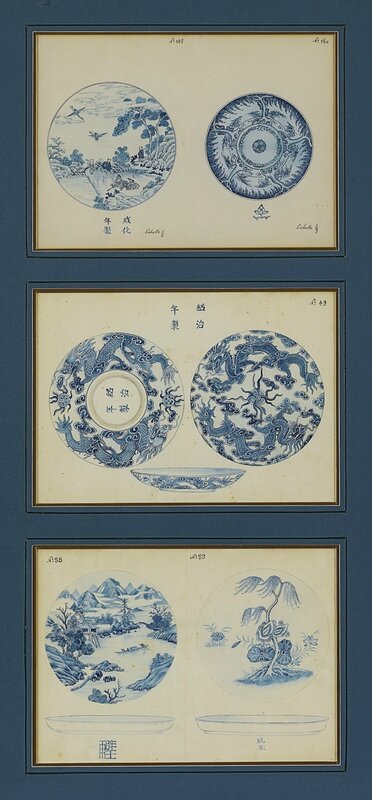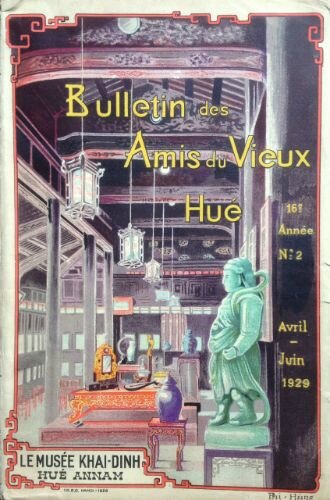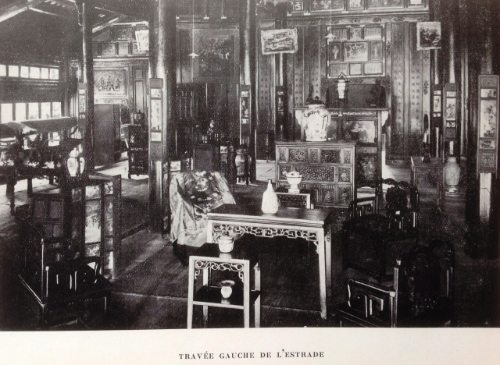Attributed to Tôn thất Sa and Trần Văn Phềnh, 20th century, circa 1900 - 1920
Lot 272. Attributed to Tôn thất Sa and Trần Văn Phềnh, 20th century, circa 1900 - 1920, Twelve drawings of Bleu de Huế (Chinese blue and white) porcelains from an important collection. Estimate 80,000 — 120,000 HKD. Lot sold 100,000 HKD. Photo: Sotheby's 2016.
watercolour and gouache on paper, in 11 parts, one of which is double-sided, (framed together as 5 pieces); each: numbered and inscribed (12), each in various size, smallest: 20.5 by 14.5 cm; 8 by 5 3/4 in., largest: 21 by 30 cm; 8 1/2 by 11 3/4 in. Executed circa 1900 - 1920. Accompanied by the original copy of Bulletin des Amis du Vieux Hué (1929)
Provenance: Private Collection, France
Notes: This exquisite series of twelve drawings is a fine example of the tastes and collecting pursuits of the Vietnamese Imperial court and aristocracy in the 19th-20th century. Each unique study represents a piece of fine Chinese porcelain, or what was known as “Blue de Hue”, blue and white Chinese export porcelain commissioned by the Vietnamese Court in the 19th century with special imperial iconography. Only a few Vietnamese artists who worked exclusively for the Imperial Court were privy to such treasures, and came to execute the beautiful studies in this present lot.
The series has been attributed to Tôn thất Sa and Trần Văn Phềnh, two of the most famous artists of the “Association des Amis du Vieux Hué” (The Association of the Friends of the Old Hue). The association was created at the beginning of the 20th century by a French reverend, Father Cadière, who had gathered a circle of French-Vietnamese collectors, amateurs, and administrators concerned with preserving the cultural and historical legacy of the Old Hue and Vietnam. Tôn thất Sa and Trần Văn Phềnh were thus known among pioneering connoisseurs of Vietnamese arts.
Careful comparisons reveal that the twelve works were inventory studies of twelve porcelain pieces from the collection of the Khai-Dinh Museum in Huế, currently named Bảo tàng Mỹ thuật Cung đình Huế(The Museum of Arts of the Imperial Court of Hue). As color photography was rare in Vietnam at the time, it was important that the imperial collection was documented with the utmost attention to detail. Some studies in the series include different perspectives, inventory numbers or collection marks, indicators of the museum’s deontological practices.
The artists’ impressively accurate drawings showcase the fineness of Chinese porcelain and the illustrative detail of the landscapes, figures and various motifs.Using gouache and watercolor to replicate the iridescent hues, the artists captured the translucency of each vase, plate and vessel. Even the delicate effect of cracking glaze has been reflected in a few of the drawings.
This lot is accompanied by a rare original copy of a 1929 issue of the Bulletin des Amis du Vieux Hué (Journal of the Friends of the Old Hué), a biannual review published by The Association of the Friends of the Old Hue from 1900 to 1945. An exclusive publication, the bulletin is sought after as the first scientific attempt to catalogue Vietnamese historical and cultural heritage. This particular issue presents the collection of the Khai-Dinh Museum and is a fine addition to the twelve unique drawings of long admired “Blue de Huế”.
Cover of Bulletin des Amis du Vieux Hué published in April – June 1929.
Illustration plates from the collection of Khai Dinh Museum published Bulletin des Amis du Vieux Hué in 1929.

/https%3A%2F%2Fprofilepics.canalblog.com%2Fprofilepics%2F1%2F0%2F100183.jpg)
/https%3A%2F%2Fstorage.canalblog.com%2F03%2F02%2F119589%2F96711876_o.jpg)
/https%3A%2F%2Fstorage.canalblog.com%2F11%2F31%2F119589%2F94773502_o.jpg)
/https%3A%2F%2Fstorage.canalblog.com%2F20%2F83%2F119589%2F94772815_o.jpg)
/https%3A%2F%2Fstorage.canalblog.com%2F26%2F72%2F119589%2F75604929_o.jpg)
/https%3A%2F%2Fstorage.canalblog.com%2F59%2F60%2F119589%2F26458628_o.jpg)














/image%2F1371349%2F20240418%2Fob_ac5c4c_telechargement.jpg)
/image%2F1371349%2F20240418%2Fob_709b64_304-1.jpg)
/image%2F1371349%2F20240418%2Fob_22f67e_303-1.jpg)
/image%2F1371349%2F20240417%2Fob_9708e8_telechargement.jpg)